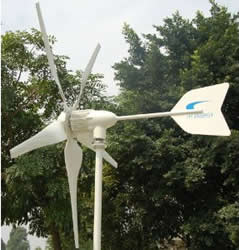
Figure 1 - Home wind generator
Most home wind turbine systems provide between 1 and 10 kilowatts of electricity. In its basic simplicity the mechanical structure of a home turbine has a propeller on a mast that is directly connected to a generator. As the wind blows it turns the propeller which turns the rotor in the generator which in turn produces electricity.
Note: Most home wind power systems require a minimum wind speed of 7 mph in order to produce enough electricity to be meaningful.
There are three basic types of home wind power systems:
- Grid Tied
- A grid tied home wind system means that the electricity that is produced by the wind turbine is converted to 120VAC, 60 Hz and is connected to the load center that feeds all of the appliances and other electrical devices that are in your home. The grid tied system relies on the grid to supply any electrical power that cannot be delivered by the home wind system, should the demand for electricity be higher than the home wind system is capable of generating or if the wind is not strong enough to produce enough electricity to meet the home’s demand for electrical power at any point in time.
- Battery Storage
- A home wind system that has battery storage delivers all of the electrical power to a bank of batteries. These batteries store the power and can be called upon to deliver their power to meet the home’s electrical demand. This is done by taking the battery’s DC stored electrical power and using an inverter to convert it to standard 120VAC 60 Hz. The advantage of the battery bank on a wind generator is that it can be storing electrical power when the demand from your home is low and then it can be used when the demand is high or when the wind is not sufficient to meet the home’s electrical demand. The use of a battery bank can easily double the initial cost of the home wind power system. It should also be noted that batteries have a limited life and will have to be replaced at some point in time.
- Hybrid
- A hybrid wind power system combines the benefits of the grid tied and battery storage systems. The hybrid wind power system allows you to stay off the grid when your wind power system can provide your home’s necessary power requirements and at times when the wind power system is generating more power than you can effectively use the system stores the excess in a bank of batteries. The power stored in the bank of batteries is then available at times when there is little wind or when more power than the system can generate is required.
Although home wind power manufacturers have their own methods of mechanically and electrically providing an overall system, their systems must fit into one of the aforementioned categories or types.
One of the biggest areas of confusion for the homeowner when contemplating the purchase of a home wind generator system is the manufacturer’s ratings. All wind generator manufacturer’s will provide a kilowatt rating for their products and while they can stand behind their rating it is difficult to compare one manufacture to another because the criteria used to specify the kilowatt rating is not based on a recognized industry standard.
The amount of power that can be delivered by a home wind generator is based on wind speed. Change the wind speed and the generator will have a completely different output and it is not linear. So if a manufacture says his wind generator system will produce 10 kilowatts at a wind speed of 10 mph, it does not mean that it will produce 5 kilowatts at a wind speed of 5 mph. In fact at a wind speed of 5 mph it may not produce any power.
Considerations for installing a home wind power generating system.
- Wind speed
- You should not consider installing a home wind generator system unless your area has a minimum 10 mph annual average wind speed. Unfortunately there is only limited information available on geographic wind speeds. Someone who is serious about the installation of a home wind generator should test the wind speed in their area at the proposed height of the wind generator. Wind speed is determined using a measuring instrument called an anemometer.
- Wind speed information that is available:
- Wind speeds throughout the US.
- Wind speeds for large US cities.
- Logistics
- A wind generator should have free, unobstructed air space all around it. As a general statement, you should have at least a 500 ft. radius of unobstructed space.
- Zoning, By-laws & Building Codes
- It is important that you obtain a building permit for the installation of your home wind generator. Check with your local building department for specific building codes and zoning requirements for the installation of home wind generator systems.
